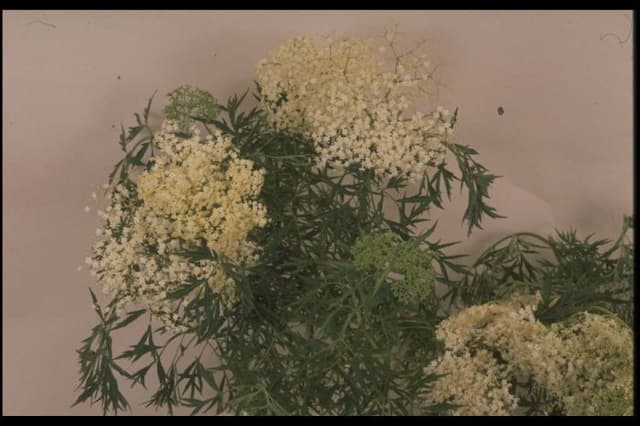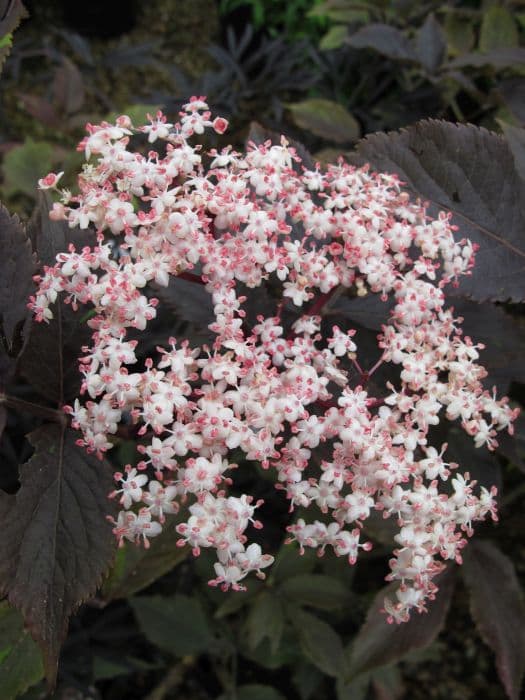European Cranberrybush Viburnum opulus

ABOUT
The plant known as the guelder rose is recognizable by its medium-green, maple-like leaves which have a somewhat lobed appearance. The foliage changes to a vibrant red or purple color as autumn approaches, offering a delightful splash of color to the landscape. Guelder rose is also admired for its beautiful flower display, consisting of showy, flat clusters of tiny white blossoms that emerge during the spring to early summer. These blossoms give off a pleasant fragrance and have a lacecap effect, with a ring of larger, sterile flowers encircling the outer edge of the cluster, drawing attention to the smaller, fertile flowers within. After the flowering period, guelder rose bears bright red berries, which can add a burst of color to the garden, and these berries are quite attractive to birds and wildlife. As for its stem, the guelder rose has a somewhat grayish-brown bark that adds to its overall visual interest, especially during the winter months when the leaves have fallen and the structure of the plant is more visible. The branch formation tends to be quite dense, creating a bushy appearance. Overall, guelder rose is known for its striking ornamental attributes that change with the seasons, providing year-round interest in the garden.
About this plant
 Names
NamesFamily
Adoxaceae.
Synonyms
Guelder-Rose, European Cranberrybush, European Cranberry Bush, European Cranberry, Snowball Tree, Cramp Bark, Dog Rowan, Water Elder, King’s Crown, Whitsun Bosses, Gaiter Tree, May Rose, Silver Bells, Red Elder, Rose Elder, Water Elder, Gilover, Dog Rowan, Whitten Tree, Ople Tree, Snowball Tree, Highbush Cranberry, Rose Elder, Pembina, American Guelder-Rose.
Common names
Viburnum lobatum, Viburnum opulus var. americanum, Viburnum trilobum, Opulus vulgaris.
 Toxicity
ToxicityTo humans
Guelder rose (Viburnum opulus) has parts that are considered mildly toxic if ingested. The plant's berries contain toxic substances, including viburnin. Symptoms of poisoning after consuming the berries of the guelder rose can include nausea, vomiting, abdominal cramps, diarrhea, and dizziness. In severe cases, ingestion may lead to more serious conditions such as low blood pressure or seizures. It is important to seek medical attention if ingestion has occurred and symptoms are present.
To pets
Guelder rose (Viburnum opulus) can also be toxic to pets, particularly dogs and cats, if ingested. The berries contain compounds that can cause gastrointestinal upset in pets, leading to symptoms such as vomiting, diarrhea, and abdominal pain. In some cases, pets may also exhibit additional signs such as lethargy, drooling, and loss of appetite. If a pet has consumed parts of the guelder rose, it is advisable to contact a veterinarian as soon as possible, especially if symptoms are observed.
 Characteristics
CharacteristicsLife cycle
Perennials
Foliage type
Deciduous
Color of leaves
Green
Flower color
White
Height
12 feet (3.66 meters)
Spread
12 feet (3.66 meters)
Plant type
Shrub
Hardiness zones
3
Native area
Europe
Benefits
 General Benefits
General Benefits- Landscape Ornamentation: The European cranberrybush, offers decorative value with its lush green leaves, white flowers, and bright red berries.
- Wildlife Attraction: It provides food and shelter for various birds and beneficial insects.
- Seasonal Interest: It has multi-seasonal appeal, featuring flowers in spring, fruits in summer and autumn, and sometimes colorful foliage in autumn.
- Privacy and Boundary Formation: Due to its dense growing habit, it can be used for hedges or living fences, providing privacy and marking property lines.
- Erosion Control: Its root system helps stabilize soil, making it useful in preventing erosion on slopes or in areas prone to soil degradation.
 Medical Properties
Medical Properties- Antispasmodic: May help relieve muscle spasms and cramps.
- Sedative: Used traditionally to aid in relaxation and to help reduce nervousness and anxiety.
- Diuretic: Promotes the production of urine, aiding in removing waste from the body.
- Astringent: Can be used to tighten tissues and reduce discharge or bleeding.
- Antiseptic: Has been used to help prevent the growth of disease-causing microorganisms.
 Air-purifying Qualities
Air-purifying QualitiesThis plant is not specifically known for air purifying qualities.
 Other Uses
Other Uses- Viburnum opulus, commonly known as the guelder rose, has berries that can be used to make a homemade ink when mixed with alum and gum arabic.
- The bark of the guelder rose can be processed to create a brown dye used in textile production.
- Its wood is hard and can be utilized for the manufacturing of small wooden objects such as tool handles and skewers.
- Young shoots and stems of guelder rose can be incorporated into basket weaving for their flexibility and strength.
- Tannin can be extracted from the bark of guelder rose for use in leather tanning processes.
- Guelder rose's rich red autumn foliage is often used as a source for natural garden mulch, adding nutrients to the soil as it decomposes.
- The plant sometimes serves as a natural fence or hedge when arranged in a closely planted row, providing privacy and aesthetic appeal.
- Guelder rose can be used as a pioneer species for rewilding projects, due to its hardy nature and low maintenance requirements.
- Due to its dense foliage, guelder rose can provide a habitat and shelter for small wildlife and birds within gardens or wilder landscapes.
- The ornamental value of guelder rose, with its attractive flowers and berries, is often capitalized on in floral arrangements and decorative wreaths during the winter season.
Interesting Facts
 Feng Shui
Feng ShuiThe European Cranberrybush is not used in Feng Shui practice.
 Zodiac Sign Compitability
Zodiac Sign CompitabilityThe European Cranberrybush is not used in astrology practice.
 Plant Symbolism
Plant Symbolism- Protection: Viburnum opulus, commonly known as Guelder Rose, is often thought to symbolize protection due to its dense, thorny branches which could serve as a physical barrier against intruders.
- Unity: The round shape of Guelder Rose's flower clusters symbolize togetherness and unity, often used in cultural ceremonies to emphasize the strength of community.
- Abundance: With its prolific clusters of berries, the Guelder Rose is seen as a symbol of abundance and prosperity.
- Good Health: The plant has historically been used for its medicinal properties, leading it to be associated with well-being and good health.
- Bereavement: In some European traditions, the Guelder Rose's fleeting flowers have made it emblematic of the transience of life, often used to express grief or remembrance.
 Water
WaterThe Snowball Bush, commonly known as Viburnum opulus, should be watered thoroughly with about 1 to 1.5 gallons of water every week during its growing season, especially if the weather is dry. During the winter months or dormant seasons, you can reduce the frequency, providing water every two to three weeks. Ensure the soil around the Snowball Bush is moist but not waterlogged, as overwatering can lead to root rot. It's best to water this plant early in the morning or late in the afternoon to reduce evaporation and allow the water to reach deeply into the soil.
 Light
LightThe Snowball Bush thrives in full sun to partial shade, preferring about 6 hours of sunlight per day. The ideal spot for this plant would have morning sun and afternoon shade, or dappled light throughout the day to prevent leaf scorch during the hottest part of the day in summer. However, it is adaptable to a variety of light conditions, doing well even in less than ideal lighting situations.
 Temperature
TemperatureThe Snowball Bush is hardy and can tolerate a wide range of temperatures, from as low as -30°F to 70°F, but it grows best in the moderate temperatures between 60°F and 70°F. This resilient deciduous shrub can survive short periods of extreme cold or heat, making it suitable for many climates across a range of hardiness zones.
 Pruning
PruningPrune the Snowball Bush to shape it and remove any dead or diseased branches, typically after the blooming season in late spring or early summer. Regular pruning helps encourage better airflow within the plant, which can reduce the risk of diseases. It's best to prune the Snowball Bush annually to maintain its shape and promote a healthy, robust growth each year.
 Cleaning
CleaningAs needed
 Soil
SoilEuropean Cranberry Bush, commonly known as Viburnum opulus, thrives best in well-drained soil rich in organic matter with a pH range of 5.6 to 6.6. An ideal soil mix would consist of two parts loam, one part peat moss or compost, and one part perlite or coarse sand to improve drainage. Regular mulching helps maintain soil moisture and temperature.
 Repotting
RepottingEuropean Cranberry Bush does not typically require frequent repotting and does so well if it's repotted every three to five years. However, if it is grown in a container, ensure it is done when the root system has outgrown the current pot or has become pot-bound.
 Humidity & Misting
Humidity & MistingEuropean Cranberry Bush prefers average garden humidity conditions. While it can handle a range of humidity levels, it is important to mimic these average conditions for optimal growth when cultivated as an ornamental plant.
 Suitable locations
Suitable locationsIndoor
Place European Cranberry Bush in a bright spot with indirect light.
Outdoor
Plant in a sunny to partial shade; water and mulch regularly.
Hardiness zone
3-8 USDA
 Life cycle
Life cycleThe life of Viburnum opulus, commonly known as Guelder Rose, begins with seed germination occurring in spring to early summer, requiring stratification to break dormancy. Seedlings emerge and establish a root system, gradually developing into juvenile plants with characteristic lobed leaves and stem growth. As the plant matures, it enters the flowering stage, typically in its third year, producing cymes of white flowers which are fertile at the outer edges and infertile in the center. After pollination by insects, the flowers develop into bright red drupes by late summer, which persist into winter and provide food for birds and wildlife, aiding seed dispersal. The plant experiences a period of dormancy during the winter when growth ceases due to cold temperatures. Over the years, the Guelder Rose reaches maturity, can live several decades and exhibits a pattern of seasonal growth and dormancy, with continual cycles of flowering and fruiting during its lifespan.
 Propogation
PropogationPropogation time
Early Spring
The most popular method of propagating Viburnum opulus, commonly known as the Guelder-rose, is through softwood cuttings. This technique is best done in late spring to early summer when the plant's new growth is still flexible but mature enough to take root easily. Cut a piece of the new growth about 4 to 6 inches (approximately 10 to 15 cm) long, making sure it has several leaves. Remove the leaves from the lower half of the cutting and dip the cut end into a rooting hormone to increase the chances of success. The cutting should then be placed in a well-draining potting mix, ensuring at least two sets of leaf nodes are below the surface of the medium. Keep the soil moist but not overly wet and place the pot in a bright area with indirect sunlight. Roots will typically develop within a few weeks, after which the new Guelder-rose plants can eventually be transplanted outdoors.









